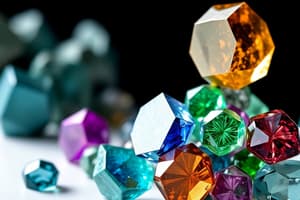Podcast
Questions and Answers
What is the term for the basic color of a gemstone determined by its selective absorption of light?
What is the term for the basic color of a gemstone determined by its selective absorption of light?
- Bodycolor (correct)
- Hue
- Tone
- Saturation
What is the term for the degree of darkness or lightness of a color?
What is the term for the degree of darkness or lightness of a color?
- Bodycolor
- Hue
- Saturation
- Tone (correct)
What is the term for areas of different color in a gemstone caused by variations in growth conditions?
What is the term for areas of different color in a gemstone caused by variations in growth conditions?
- Fine color
- Extinction
- Color zoning (correct)
- Unplanned color zoning
What is the term for the selection of colors in which a gemstone occurs?
What is the term for the selection of colors in which a gemstone occurs?
What is the term for the strength or intensity of a color?
What is the term for the strength or intensity of a color?
What is the term for dark areas in a faceted transparent colored stone?
What is the term for dark areas in a faceted transparent colored stone?
What is the term for visible face-up color zoning that was planned during the cutting process?
What is the term for visible face-up color zoning that was planned during the cutting process?
What is the term for light that exits through a gem’s crown in a controlled way due to the correct proportions of its cut?
What is the term for light that exits through a gem’s crown in a controlled way due to the correct proportions of its cut?
What is the term for an area of weak saturation in a transparent gemstone’s bodycolor?
What is the term for an area of weak saturation in a transparent gemstone’s bodycolor?
Which of the following colors is considered most desirable by the trade?
Which of the following colors is considered most desirable by the trade?
What causes unintended color zoning in a gemstone?
What causes unintended color zoning in a gemstone?
What is the result of unplanned light leakage in a gemstone?
What is the result of unplanned light leakage in a gemstone?
What term is used to describe a gemstone's link to a specific geographic location?
What term is used to describe a gemstone's link to a specific geographic location?
What is the purpose of intended color zoning in a gemstone?
What is the purpose of intended color zoning in a gemstone?
What happens when a gemstone is cut incorrectly?
What happens when a gemstone is cut incorrectly?
What is the term for the color that a gemstone appears to be at first glance?
What is the term for the color that a gemstone appears to be at first glance?
What is the result of a gemstone being cut with the correct proportions?
What is the result of a gemstone being cut with the correct proportions?
What is the term for a gemstone's color range?
What is the term for a gemstone's color range?
Flashcards are hidden until you start studying
Study Notes
Color Terminology
- Bodycolor refers to a gemstone's basic color, determined by its selective absorption of light.
- Saturation is a measure of a color's strength or intensity.
- Color range refers to the selection of colors in which a gemstone occurs.
- Tone is the degree of darkness or lightness of a color.
- Color zoning refers to areas of different color in a gem, caused by variations in growth conditions.
Trade Terms and Color Descriptions
- Trade terms are used in the jewelry industry to describe particular gemstone colors or link gems with specific geographic locations.
- Fine color refers to the color or colors in a gemstone's color range considered by the trade to be the most desirable.
- Hue is the first impression of an object's basic color.
Optical Phenomena
- Extinction refers to dark areas in a faceted transparent colored stone.
- Unintended color zoning refers to visible face-up color zoning that the cutter was unable to conceal.
- Intended color zoning refers to visible face-up color zoning that was planned during the cutting process.
- Unplanned light leakage refers to light that exits through the pavilion in an uncontrolled way due to compromises in a gem's proportions.
- Planned light leakage refers to light that exits through a gem's crown in a controlled way due to the correct proportions of its cut.
- Window refers to an area of weak saturation in a transparent gemstone's bodycolor that usually results from the way the gem was cut.
Color Terminology
- Bodycolor refers to a gemstone's basic color, determined by its selective absorption of light.
- Saturation is a measure of a color's strength or intensity.
- Color range refers to the selection of colors in which a gemstone occurs.
- Tone is the degree of darkness or lightness of a color.
- Color zoning refers to areas of different color in a gem, caused by variations in growth conditions.
Trade Terms and Color Descriptions
- Trade terms are used in the jewelry industry to describe particular gemstone colors or link gems with specific geographic locations.
- Fine color refers to the color or colors in a gemstone's color range considered by the trade to be the most desirable.
- Hue is the first impression of an object's basic color.
Optical Phenomena
- Extinction refers to dark areas in a faceted transparent colored stone.
- Unintended color zoning refers to visible face-up color zoning that the cutter was unable to conceal.
- Intended color zoning refers to visible face-up color zoning that was planned during the cutting process.
- Unplanned light leakage refers to light that exits through the pavilion in an uncontrolled way due to compromises in a gem's proportions.
- Planned light leakage refers to light that exits through a gem's crown in a controlled way due to the correct proportions of its cut.
- Window refers to an area of weak saturation in a transparent gemstone's bodycolor that usually results from the way the gem was cut.
Studying That Suits You
Use AI to generate personalized quizzes and flashcards to suit your learning preferences.




